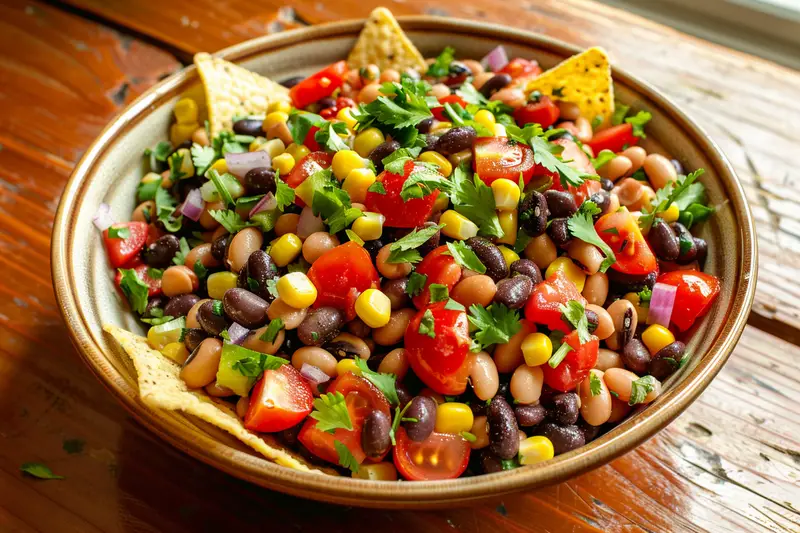Korean cuisine is known for its bold flavors, rich spices, and comforting dishes. But what if you’re following a plant-based diet? Luckily, many Korean recipes can be easily veganized without sacrificing authenticity. From bibimbap to kimchi and tteokbokki, you can enjoy all the iconic Korean flavors in a cruelty-free way.
In this guide, we’ll explore the best vegan Korean recipes, including essential ingredients, must-try dishes, and tips for making your favorite Korean meals plant-based. Whether you’re looking for a spicy stew, savory pancakes, or a hearty rice bowl, vegan Korean recipes offer endless possibilities that are both delicious and nutritious.
With the right ingredients and a few simple substitutions, you can recreate authentic vegan Korean recipes at home, maintaining the bold umami flavors that make Korean cuisine so special. From fermented soybean pastes to perfectly seasoned tofu, every dish is a celebration of traditional flavors made entirely plant-based.
If you’re new to vegan Korean recipes, don’t worry! This guide will walk you through everything you need to know, from pantry essentials to step-by-step recipes that bring the taste of Korea to your table—without any animal products.
Table of Contents
Introduction to Vegan Korean Recipes
The Rise of Veganism in Korea
Although South Korea is traditionally known for its meat-heavy dishes, the country has been witnessing a significant rise in plant-based eating. The increasing awareness of health benefits, environmental concerns, and ethical considerations has led many Koreans to embrace vegan Korean recipes as part of their daily meals.
Major cities like Seoul, Busan, and Incheon now offer a growing number of vegan-friendly restaurants and markets, making it easier than ever to enjoy authentic vegan Korean recipes without animal products. From street vendors selling vegan Korean recipes like kimbap and tteokbokki to fully plant-based Korean BBQ spots, the movement is steadily gaining momentum.
As more people recognize the versatility and flavor of vegan Korean recipes, traditional dishes are being adapted using plant-based alternatives like tofu, mushrooms, and fermented soybean pastes. This shift is not only making Korean cuisine more inclusive but also proving that bold, umami-rich flavors can be achieved without meat or dairy.
Why Korean Cuisine is Easy to Veganize
One of the best things about Korean food is that many of its key ingredients are naturally plant-based. Staples like:
- Rice (short-grain, sticky, and brown rice)
- Fermented vegetables (kimchi, pickled radish)
- Soy-based sauces (gochujang, doenjang, soy sauce)
- Seaweed (nori, gim, wakame)
- Tofu and mushrooms (common meat alternatives in Korean dishes)
By substituting meat with tofu, jackfruit, or mushrooms, and replacing fish sauce with miso or soy sauce, you can enjoy almost any traditional Korean dish in a vegan-friendly way.
Essential Ingredients in Vegan Korean Recipes
Traditional Korean Ingredients That Are Naturally Vegan
If you want to recreate authentic Korean flavors at home, stock your kitchen with these essential ingredients:
| Ingredient | Description | Use in Vegan Cooking |
|---|---|---|
| Gochujang | Fermented red chili paste | Adds heat & umami to stews, sauces, and marinades |
| Doenjang | Fermented soybean paste | Base for soups and stews (like Doenjang Jjigae) |
| Gochugaru | Korean red pepper flakes | Used in kimchi, tteokbokki, and stir-fries |
| Sesame Oil | Nutty, aromatic oil | Drizzle over dishes for rich flavor |
| Soy Sauce | Salty and umami-rich | Used in marinades, dipping sauces, and soups |
| Rice Vinegar | Light and tangy | Adds acidity to dressings and sauces |
| Tofu & Mushrooms | Great meat substitutes | Used in bibimbap, stews, and BBQ dishes |
| Seaweed (Gim) | Dried or roasted seaweed | Wrapped around rice dishes like kimbap |
Must-Have Vegan Substitutes for Korean Dishes
Some Korean Recipes contain animal-based ingredients, but you can easily swap them for plant-based alternatives:
| Non-Vegan Ingredient | Vegan Substitute |
|---|---|
| Fish Sauce | Soy sauce + seaweed + miso |
| Beef Broth | Vegetable broth + mushrooms |
| Egg (for bibimbap, pancakes) | Flaxseed egg or silken tofu |
| Meat (for bulgogi, BBQ) | Jackfruit, mushrooms, or tofu |
By using these ingredients and substitutions, you can make authentic-tasting vegan Korean recipes at home without missing out on the traditional flavors.
Classic Vegan Korean Recipes
Now that you have your essential ingredients, let’s dive into some delicious classic Vegan Korean Recipes that you can make at home!
1. Vegan Bibimbap – Colorful Korean Rice Bowl
Bibimbap is one of Korea’s most famous dishes. It’s a bowl of warm rice, topped with sautéed vegetables, marinated tofu, and spicy gochujang sauce.
Ingredients:
- 1 cup cooked short-grain rice
- ½ cup mushrooms (shiitake or oyster), sliced
- ½ cup spinach, blanched
- ½ cup carrots, julienned
- ½ cup zucchini, julienned
- ½ block firm tofu, sliced and pan-fried
- 2 tbsp gochujang (Korean chili paste)
- 1 tbsp soy sauce
- 1 tsp sesame oil
- 1 tsp toasted sesame seeds
Instructions:
- Sauté the mushrooms, carrots, and zucchini separately in sesame oil until tender.
- Arrange the cooked rice in a bowl, placing the vegetables and tofu on top.
- Add gochujang and a drizzle of soy sauce.
- Sprinkle sesame seeds and mix everything before eating!

2. Plant-Based Kimchi – Fermented Spicy Cabbage
Traditional kimchi contains fish sauce and shrimp paste, but you can make a vegan version using miso paste.
Ingredients:
- 1 head Napa cabbage, chopped
- 2 tbsp sea salt
- 2 tbsp gochugaru (Korean chili flakes)
- 1 tbsp miso paste
- 1 tbsp grated ginger
- 1 tbsp minced garlic
- 1 tbsp sugar
- 2 green onions, chopped
Instructions:
- Massage salt into cabbage and let it sit for 1-2 hours until softened.
- Rinse well and squeeze out excess water.
- Mix miso, gochugaru, ginger, garlic, and sugar into a paste.
- Coat the cabbage with the mixture and place in an airtight jar.
- Let it ferment at room temperature for 2-3 days before refrigerating.
3. Japchae – Sweet Potato Noodles with Vegetables
Japchae is a sweet and savory noodle dish made with glass noodles and stir-fried vegetables.
Ingredients:
- 8 oz sweet potato glass noodles (dangmyeon)
- ½ cup mushrooms, sliced
- ½ cup bell peppers, julienned
- ½ cup carrots, julienned
- ½ block tofu, cubed and pan-fried
- 2 tbsp soy sauce
- 1 tbsp sesame oil
- 1 tsp sugar
- 1 tsp toasted sesame seeds
Instructions:
- Cook the glass noodles according to the package instructions and rinse under cold water.
- Sauté mushrooms, peppers, and carrots in sesame oil.
- Toss the noodles with soy sauce, sugar, and the cooked vegetables.
- Add pan-fried tofu and garnish with sesame seeds.
Korean Vegan Soups and Stews
Vegan Korean Recipes is famous for its hearty, flavorful soups and stews. Many traditional recipes can be easily made vegan by swapping out the animal-based ingredients with plant-based alternatives. Here are some must-try vegan Korean soups and stews that will warm your soul.
1. Doenjang Jjigae – Savory Soybean Paste Stew
Doenjang Jjigae is a rich and flavorful stew made with doenjang (fermented soybean paste). It’s a beloved comfort food in Korea, perfect for chilly days.
Ingredients:
- 2 tbsp doenjang (soybean paste)
- 4 cups vegetable broth
- 1 block tofu, cubed
- 1 zucchini, sliced
- ½ onion, diced
- 1 cup mushrooms (shiitake or oyster)
- 1 tbsp gochugaru (Korean red pepper flakes)
- 2 green onions, sliced
Instructions:
- Boil the vegetable broth in a pot.
- Add the doenjang and stir until fully dissolved.
- Add zucchini, onions, mushrooms, and tofu to the pot.
- Simmer for 10-15 minutes until the vegetables are tender.
- Garnish with green onions before serving.
2. Vegan Kimchi Jjigae – Spicy Fermented Stew
Kimchi Jjigae is a spicy and tangy stew made with fermented kimchi. By using vegan kimchi, you can enjoy this classic dish without the fish-based ingredients.
Ingredients:
- 2 cups vegan kimchi
- 4 cups vegetable broth
- 1 block tofu, sliced
- ½ onion, chopped
- 1 tbsp gochugaru (Korean red pepper flakes)
- 1 tbsp soy sauce
- 1 tsp sesame oil
- 2 green onions, chopped
Instructions:
- In a pot, sauté onions and vegan kimchi in sesame oil.
- Add vegetable broth and bring to a boil.
- Add tofu, gochugaru, and soy sauce.
- Simmer for 15 minutes and garnish with green onions before serving.

Popular Vegan Korean Street Food
Korean street food is known for its bold flavors and fun textures. Many street food classics can be made vegan by removing the meat or fish-based ingredients and substituting plant-based alternatives. Here are some veganized versions of popular Korean street foods.
1. Tteokbokki – Spicy Rice Cakes with a Vegan Twist
Tteokbokki is one of Korea’s most popular street foods, featuring chewy rice cakes in a spicy gochujang-based sauce. This vegan version keeps all the heat and flavor.
Ingredients:
- 1 lb Korean rice cakes (tteok)
- 2 cups vegetable broth
- 3 tbsp gochujang (Korean chili paste)
- 1 tbsp soy sauce
- 1 tbsp sugar
- 2 green onions, sliced
- 1 tsp toasted sesame seeds
Instructions:
- In a pot, mix vegetable broth, gochujang, soy sauce, and sugar.
- Bring the mixture to a boil and add the rice cakes.
- Simmer for 10 minutes, stirring occasionally.
- Garnish with green onions and sesame seeds before serving.
2. Kimbap – Seaweed Rolls Without Fish
Kimbap is often compared to sushi but has distinctly Korean flavors, with ingredients like pickled radish and sesame oil. This vegan version replaces fish with marinated tofu.
Ingredients:
- 4 sheets of gim (seaweed)
- 2 cups cooked short-grain rice
- ½ block tofu, marinated and pan-fried
- ½ cucumber, julienned
- 1 carrot, julienned
- 2 tbsp sesame oil
- 1 tsp sesame seeds
Instructions:
- Spread cooked rice evenly on the seaweed sheet.
- Arrange tofu, cucumber, and carrots in a line near the bottom of the sheet.
- Roll the seaweed tightly and slice into bite-sized pieces.
- Drizzle with sesame oil and sprinkle with sesame seeds before serving.
Vegan Korean BBQ – Meat-Free Grilling
Korean BBQ is a social dining experience, where diners grill their own meat at the table. But you don’t need meat to enjoy a great Korean BBQ! Here are some vegan-friendly alternatives that are just as flavorful.
1. Bulgogi-Style Marinated Tofu
Bulgogi is a popular Korean BBQ dish known for its sweet and savory marinade. This version uses tofu instead of beef.
Ingredients:
- 1 block firm tofu, sliced
- 2 tbsp soy sauce
- 1 tbsp sesame oil
- 1 tbsp sugar
- 2 cloves garlic, minced
- 1 tsp grated ginger
- 1 tsp gochugaru (optional)
Instructions:
- In a bowl, mix soy sauce, sesame oil, sugar, garlic, and ginger to make the marinade.
- Marinate the tofu slices for 30 minutes.
- Grill the tofu on a hot pan until browned on both sides.
2. Essential Side Dishes (Banchan)
No Korean meal is complete without banchan, which are small side dishes served with the main meal. Here are some vegan-friendly options:
- Kimchi (made with plant-based ingredients)
- Spicy cucumber salad (oi muchim)
- Seasoned spinach (sigeumchi namul)
- Braised potatoes (gamja jorim)
Vegan-Friendly Condiments and Sauces
Korean cuisine is known for its bold, spicy, and umami-rich flavors, which often come from its signature condiments and sauces. Many traditional Korean sauces contain fish sauce or other animal-derived ingredients, but with the right substitutions, you can easily enjoy authentic Korean flavors in a fully vegan way.
1. Gochujang – The Spicy Heart of Korean Cuisine
Gochujang is a fermented red chili paste that adds depth and heat to many Korean dishes. Traditional gochujang is often vegan, but some brands may contain honey or other animal-derived ingredients.
How to Use Gochujang in Vegan Cooking:
- Tteokbokki: Adds spice to the rice cake sauce.
- Bibimbap: Mixed with sesame oil and soy sauce for a bold rice bowl topping.
- Marinades: Used for grilled tofu, mushrooms, and plant-based bulgogi.
Vegan Gochujang Substitutes:
If you don’t have gochujang on hand, you can mix:
- Miso paste + red chili flakes + maple syrup for a similar flavor.
2. Soy Sauce-Based Dipping Sauces
Soy sauce is a staple in Korean cuisine and is naturally vegan. You can use it as a base for dipping sauces to enhance the flavors of dumplings, pancakes, and grilled vegetables.
Simple Vegan Soy Sauce Dipping Sauce Recipe:
- 2 tbsp soy sauce
- 1 tbsp rice vinegar
- 1 tsp sesame oil
- ½ tsp gochugaru (Korean red pepper flakes)
- 1 clove garlic, minced
Use this sauce for:
- Dipping vegan mandu (Korean dumplings)
- Drizzling over Japchae (glass noodles)
- Serving alongside scallion pancakes
Korean Desserts and Beverages for Vegans
Korean desserts and beverages often include dairy and eggs, but many traditional sweets can be easily adapted into vegan Korean recipes without losing their authentic flavors. With simple substitutions like plant-based milk, coconut cream, and natural sweeteners, you can enjoy all the richness of classic Korean treats in a cruelty-free way.
1. Sikhye – Traditional Sweet Rice Drink
Sikhye is a sweet, refreshing rice drink made with barley malt powder and cooked rice. It’s a common drink served during Korean holidays and celebrations.
Ingredients:
- ½ cup cooked rice
- 5 cups water
- ½ cup barley malt powder
- ¼ cup sugar
Instructions:
- Mix barley malt powder with warm water and let it sit for 1 hour. Strain and discard the solids.
- Add the liquid to a pot with cooked rice and simmer for 1 hour.
- Add sugar and chill before serving.

2. Is Soju Vegan?
Soju, Korea’s most famous alcoholic drink, is usually vegan, but some brands may use animal-derived filtration agents.
Vegan-Friendly Soju Brands:
- Jinro Soju
- Chum Churum Soju
- Good Day Soju
Always check labels or choose unflavored soju for a vegan option.
Tips for Eating Vegan in Korea
Traveling to Korea or dining out? While South Korea is famous for its meat-heavy dishes, there are plenty of vegan options if you know where to look!
1. How Vegan-Friendly is South Korea?
While Korea is not as vegan-friendly as the UK or Germany, the vegan movement is growing. Big cities like Seoul and Busan have many vegan-friendly restaurants and plant-based menu options.
How to Find Vegan Food in Korea:
- Look for “채식” (chaesik), which means vegetarian/vegan in Korean.
- Use apps like HappyCow to find vegan restaurants.
- Stick to Buddhist temple food, which is always vegan.
2. Best Vegan Restaurants in Korea
Here are some of the best vegan restaurants in Korea:
| Restaurant | Location | Specialty |
|---|---|---|
| Plant Café | Seoul | Vegan burgers and desserts |
| Loving Hut | Various locations | Vegan Korean dishes |
| Osegye Hyang | Seoul | Traditional Buddhist temple food |
| Vegetus | Seoul | Vegan brunch and pasta |
These spots offer delicious plant-based meals, so you can enjoy Korean cuisine without animal products.
3. Finding Vegan Options in Traditional Korean Markets
Even in traditional Korean markets, you can find plenty of vegan-friendly foods.
Vegan Snacks to Look for in Korean Markets:
- Gimbap (without fish or egg) – Rice rolls wrapped in seaweed.
- Hoddeok – Sweet pancakes filled with brown sugar and cinnamon.
- Roasted chestnuts and sweet potatoes – Common street snacks.
- Jeon (savory pancakes) – Made with scallions or kimchi (check for egg).
With a little planning, you can easily enjoy vegan Korean food while traveling or dining out.
Conclusion: Embracing Vegan Korean Recipes for a Flavorful Plant-Based Experience
Exploring vegan Korean recipes opens up a world of bold flavors, rich textures, and wholesome ingredients, all without the need for animal products. Whether you’re a longtime vegan or just looking to add more plant-based meals to your diet, there are countless ways to enjoy the best of Korean cuisine. From vegan Korean recipes like bibimbap and tteokbokki to comforting stews and grilled BBQ alternatives, the possibilities are endless.
One of the biggest advantages of vegan Korean recipes is their reliance on naturally plant-based ingredients, such as tofu, mushrooms, seaweed, and fermented soybean pastes. By making simple substitutions—like replacing fish sauce with soy sauce or using mushrooms instead of meat—you can transform traditional dishes into satisfying plant-based versions without sacrificing authentic flavors.
The growing popularity of vegan Korean recipes is also making it easier than ever to find plant-based options, whether you’re cooking at home, dining out, or even visiting Korea. Many restaurants now offer vegetarian or fully vegan dishes, and the rise of plant-based alternatives in Korean markets means you can easily recreate your favorite meals at home.
For those new to vegan Korean recipes, starting with classic dishes like vegan kimchi, japchae, or spicy tofu stew is a great way to introduce yourself to the vibrant flavors of Korean cuisine. The key is to experiment with traditional condiments like gochujang, doenjang, and sesame oil to achieve the perfect balance of heat, umami, and sweetness in your dishes.
By incorporating vegan Korean recipes into your meal plan, you not only get to enjoy the deliciousness of Korean food but also benefit from a nutrient-rich diet that supports your health and the environment. Whether you’re craving a hearty stew, a spicy noodle dish, or a refreshing dessert, there’s always a vegan Korean recipe to satisfy your taste buds.
Learn more about Vegenaise Recipe







